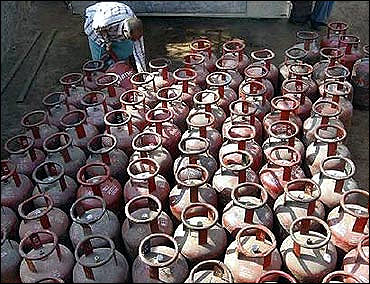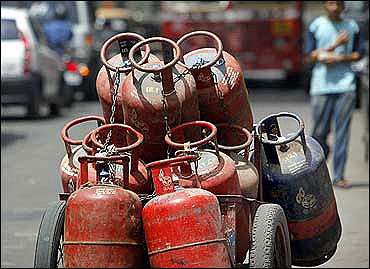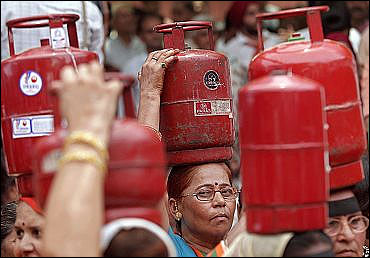 | « Back to article | Print this article |
You may get only 4 gas cylinders a year at low rates
Brace yourself to shell out more towards your household expenses if the Union government gets its way on the number of subsidised LPG cylinder one is entitled to.
In an Empowered Group of Ministers' meet, on Friday, headed by Finance Minister Pranab Mukherjee the government and its allies with discuss the issue of allowing only four subsidised cooking gas cylinders in a year.
All subsequent cylinders will have a non-subsidised rate that will be fixed every month. And if you volunteer to forsake the subsidised refills altogether, you are most welcomed to do so.
Irrespective of the political storm that such a move would raise, the fear is now that the meet itself may get scuttled.
Dravida Munnetra Kazhagam an ally of the United Progressive Alliance government at the Centre has decided to urge its representative MK Alagiri to skip the meet.
Click on NEXT for more...
You may get only 4 gas cylinders a year at low rates
In all probabilities Union Railway Minister Dinesh Trivedi of the Trinamool Congress, another ally of the UPA, will also be taking the same line.
Both DMK and TMC are facing civic elections in Tamil Nadu and West Bengal.
The new policy will save the government Rs 12,629 crore (Rs 126.29 billion) a year in terms of high subsidy it shares with the oil companies.
The figure of four refills a year is based on the pattern of consumption of gas by the BPL (below poverty line) families.
The current subsidy on domestic LPG in Delhi is Rs 275 per cylinder and it is around that figure across India.
EGoMs have full authority to take decisions on behalf of the government, without routing them through the Union Cabinet.
Besides the finance minister, Petroleum Minister Jaipal Reddy, Agriculture Minister Sharad Pawar, Power Minister Sushil Kumar Shinde, Road Transport and Highways Minister C P Joshi and Railway Minister Dinesh Trivedi of Trinamool Congress are also part of this EGoM.
Click on NEXT for more...
You may get only 4 gas cylinders a year at low rates
The agenda document seeks EGoM's approval on five issues concerning supply of LPG for cooking purpose.
Maximum number of subsidised refills to a customer to be limited to four in one year.
Creation of two categories of customers as per entitlement for subsidised and non-subsidised refills.
Customers willing to forsake the four subsidised refills will be encouraged to do so voluntarily as a first step.
Introduction of a non-subsidised rate for domestic LPG, in addition to the existing subsidised rate, and it will be subject to change on a monthly basis.
Any increase in the distributor's commission on account of higher working capital due to dual rates of LPG to be passed in the retail selling price of the LPG to the customer. A decision may be taken as to whether non-subsidised domestic LPG be exempted from levy of customs and excise duty.
Click on NEXT for more...
You may get only 4 gas cylinders a year at low rates
A lengthy note circulated to the EGoM members says the scheme proposed would be the easiest to implement and monitor as the entire customer record is computerised and so the change can be administered without any additional inputs from the field.
It says: "The figure of four refills is in consonance with the pattern of LPG refills consumed by BPL families and consistent with the recommendation of limiting subsidy to BPL households only.
"This will reduce the burden of subsidy by Rs 12,629 crore at the average rate of subsidy for the year 2010-11 and with the expansion of customer base, it will have an incremental impact."
The number of domestic LPG connections has grown significantly with 4.82 crore connections added between March 2004 and March 2011.
The government has been fixing quota of every subsidised item it provides through the public distribution system (PDS) and also deciding the eligible beneficiaries for such items, but that were not so in case of the LPG supplied for domestic cooking at the universal subsidy without any quota, the note points out.
Noting that the issues relating to rationalisation of kerosene and LPG distribution have been discussed at various levels, including the study reports on pricing demand system and supply of petroleum products conducted from time to time, the note says: "This proposal is aimed at rationalising the distribution of LPG by introducing a ceiling on the number of subsidised gas cylinders."



